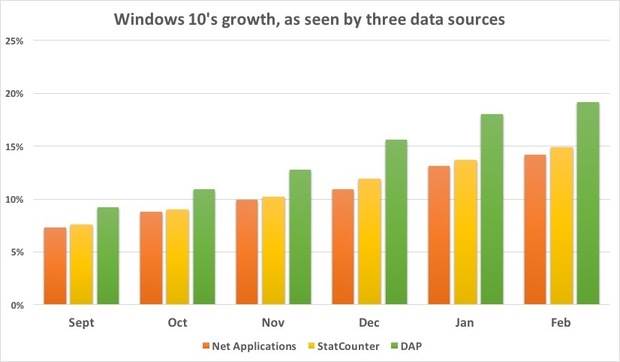Just how successful is Microsoft’s Windows 10? If speed of enterprise adoption is any measure, perhaps one of the most successful ever. Windows 10 is set to rank as the most widely installed enterprise Windows version in Microsoft operating system history, according to market research firm Gartner Inc.
That would put it on a projectory similar to the popular Windows XP and Windows 7 versions of the company’s flagship software. Specifically, Gartner is predicting half of enterprises will have at least started deploying Windows 10 by January 2017.
“In the consumer market, a free upgrade coupled with broad legacy device support and automatic over-the-air upgrades ensures that there will be tens of millions of users familiar with the operating system before the end of 2015,” said Steve Kleynhans, research vice president at Gartner, in a statement. “For enterprises, we expect that implementation will be significantly more rapid than that seen with Windows 7 six years ago.”
Three Key Predictions
Next question: Why is Windows 10 so popular? Gartner pointed out several factors, including a stark awareness of the fact that Microsoft is ending Windows 7 support in January 2020, as well as compatibility with Windows 7 apps and devices and a pent-up demand for 2-in-1 devices and tablets in the enterprise.
The net effect: Many enterprises are planning to launch Windows 10 pilot programs in the first half of 2016. With at least half of enterprises starting some production deployments in 2017, Windows 10 could become the new standard by 2019.
Gartner also made three more predictions on the endpoint technology front. For starters, the firm said by 2019, organizations will deliver twice as many remote applications as in 2015.
“Organizations will centralize a number of applications over the next three years to enable platform- independent computing,” said Nathan Hill, research director at Gartner, in the statement. “As platform-specific Windows applications dip below a certain threshold and become a ‘manageable minority’ — that is 20 to 30 percent of the application portfolio — organizations will find it increasingly financially and operationally attractive to ring-fence all of them using device-independent delivery options.”
Touchscreen Trend Growing
By 2018, one-third of all notebooks will be touchscreen, according to Gartner. And in that same year, 30 percent of enterprises will spend more on display screens than on PCs thanks to the user demand in the digital workplace, the company said.
“All of these trends portend a new employee workspace that is more mobile, more capable of working more naturally with humans, and, overall, more productive and secure. Endpoint support staff must rethink the workspace and work with suppliers to re-architect and re-cost standards,” said Gartner analyst Ken Dulaney in the statement.
“From an IT perspective, Windows 10 and the move of applications to the back end will dramatically change how those applications are delivered to employees. Updates will be more frequent, more incremental and less obvious to the end user,” he said. “Software vendors and internal IT have much to do to adapt to this new model and to move away from the image management model for PCs of today.”
Accurate Predictions?
We caught up with Rob Enderle, principal analyst at the Enderle Group, to get his thoughts on the Gartner report. He told us Gartner’s predictions are both interesting and intuitive.
“The move to Windows 10, which addresses the problems with Windows 8 coupled with the huge number of firms that stalled on Windows XP, provides the opportunity for a massive upgrade,” Enderle said. “Had Windows 10 not been as good as it was, a good chunk of these firms might have moved instead to the Chrome OS or even the Mac OS. But Microsoft pulled this out by the skin of its teeth and the vast majority of movement is to Windows 10.”
The familiarity with touchscreens on tablets and the increased focus on designing Web sites and applications for touch use is driving the massive move to touchscreens, according to Enderle. And that backs Gartner’s prediction on this movement on laptops, he said. Ironically, Apple, which actually enabled this movement, appears to have missed its own meeting by not embracing touchscreen capabilities on MacBooks and iMacs, he added.
“I think Gartner’s timeline on remote apps is overly conservative and [I] expect the 50 percent mark of hosted applications will likely come in the late 2017 time frame largely due to the need to access many of these apps from an ever more diverse group of mobile devices,” Enderle said. “Overall, the Gartner report is likely conservative, probably because these changes are being driven by line management and not IT — and IT talks to Gartner; line management doesn’t. So the report accurately states direction but understates rate of change as a result.”







